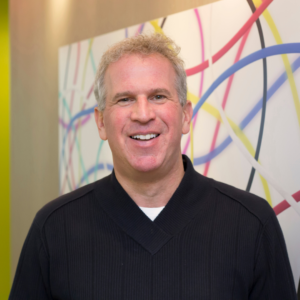Stepping up to say hello
At night it sends a glowing welcome, and both day and night it extends services and activities to residents and visitors at the C.C. Young CCRC in Dallas, Texas. It’s a new activities building purposely designed to attract the community-at-large to the previous senior-care-focused campus. And, as such, it typifies the broadening outreach of long-term care organizations in today’s marketplace. Recently designers Daniel Cinelli (Principal-in-Charge), Jason Dobbin (Architecture Team Member), JinHwa “Gina” Park (Architecture Team Member), and Jennifer McDermott (Interiors Team Member), all of the Perkins Eastman design firm, shared insights on the project’s details and mission with Long-Term Living Editor-in-Chief Richard L. Peck.
Peck: The building is strikingly contemporary looking. How did that come to be?
Cinelli: A donor wanted something that looked inviting to the community, and there was a lot of discussion of how to get kids and families to come and to make this look like “neutral turf,” not claimed by any one age group.
Dobbin: Actually, the team was going for “timelessness” rather than “contemporary,” in my view. “Contemporary” can itself be dated after awhile. We wanted the design to relate to the ageless qualities of visitors and of CCRC residents.
Peck: Does the new building have ease of access for everyone?
Cinelli: It’s smack-dab in the middle of the campus. It is replacing a multipurpose building that was taken down to make room for a park, which is another added attraction. At night the building, with its large windows, serves as a beacon, providing a central focus for everyone.
Peck: How does this facility accommodate the broad community?
McDermott: It has a variety of offerings for multiple age groups, including a fitness center with state-of-the-art, senior-friendly equipment, a café/lounge with a fireplace and a flat-screen TV, with lounge-type seating.
Dobbin: It has a theater which can be divided in half so that a movie and a live performance can go on simultaneously, if so desired. The glass back wall of the theater opens to the outside to create a performance pavilion for interested passersby. Classrooms also open on to a central courtyard, where residents and visitors can do tai chi and other exercises.
McDermott: And opposite from the fitness area is the art area, where easels can be brought to the outside on good weather days.
Cinelli: This differs from many CCRCs in that they often make you feel as though you’re visiting a country club, and it’s strictly hands-off for the kids. This is more relaxed and comfortable, even though it is designed to fully accommodate handicapped residents with appropriate lighting, carpet, and other materials.
Park: The layout of the building and the various offerings are all about mind, body, and spirit.
Dobbin: Yes, it’s life enrichment—for the mind (library, classrooms, materials on healthy aging), body (the fitness center and healthy dining), and the spirit (a theater accommodating speakers, concerts, and performers, as well as a chapel).
Cinelli: And, interestingly enough, the facility is able to offer this variety because of highly unusual partnerships it has set up with outside organizations, schools, and hospitals throughout the community. C.C. Young has 22 such partners, telling them in so many words, “We have this beautiful building, now you figure out a way to put it to best use.” For example, it houses a wellness center that is part of the Cooper Wellness franchise; it offers space to the Alzheimer’s Association of Dallas; and it provides a forum for the Osher Institute, which involves university faculty in on-campus presentations and lectures. The basic idea is that a not-for-profit doesn’t have to do it all. It can work with others outside the organization to bring enrichment to both residents and the community-at-large.
Peck: How has all this worked so far with residents on-campus?
Cinelli: We just did a review of this. Initially residents were a little hesitant to use this facility. Use by the community, on the other hand, has been incredibly high, so management has made an effort to make sure residents don’t feel intimidated or excluded. And this integration of resident and community visitors is improving. To encourage this, the distances from the skilled facility and the assisted living units to the new building are only several yards long, and the building has multiple entrances for ease of access. The general idea is one of openness to everyone.
For more information, visit https://www.perkinseastman.com. To send your comments to the editors, e-mail 2peck1008@iadvanceseniorcare.com.
Long-Term Living 2008 October;57(10):26-27

Richard L. Peck was editor in chief of I Advance Senior Care / Long-Term Living for 18 years. For eight years previous to that, he served as editor of the clinical magazine Geriatrics. He has written extensively on developments in the field of senior care and housing.
Related Articles
Topics: Articles , Housing











